Cutting-edge schemes and a push for player safety are creating radical evolutions in football’s most basic element. Welcome to the last days of the down lineman.
Last November, in an otherwise mundane Week 10 meeting of noncontenders, the Chargers and Dolphins offered a glimpse into what might well be football’s future.
Facing third-and-10 late in the second quarter, trailing by seven, L.A.’s rookie quarterback, Justin Herbert, counted off five receivers and surveyed an atypical defensive front from his usual shotgun roost. Of the six Miami defenders milling around the box, none had a hand anchored to the ground. In fact, neither did any of the linemen charged with protecting Herbert. As the play clock ticked down, every player on the field stood, save for one: center Dan Feeney.
At the snap, four of the Dolphins up front sprinted forward, intent on whizzing by backpedaling linemen rather than hunkering down and bulldozing through them. Herbert’s protectors parried the charge by shuffling their feet and shoving. The men met with eyes up, not helmets down, and in the end linebacker Andrew Van Ginkel managed to burn around the outside of left tackle Sam Tevi, bump the QB as he threw and send the pass wayward, forcing a punt.
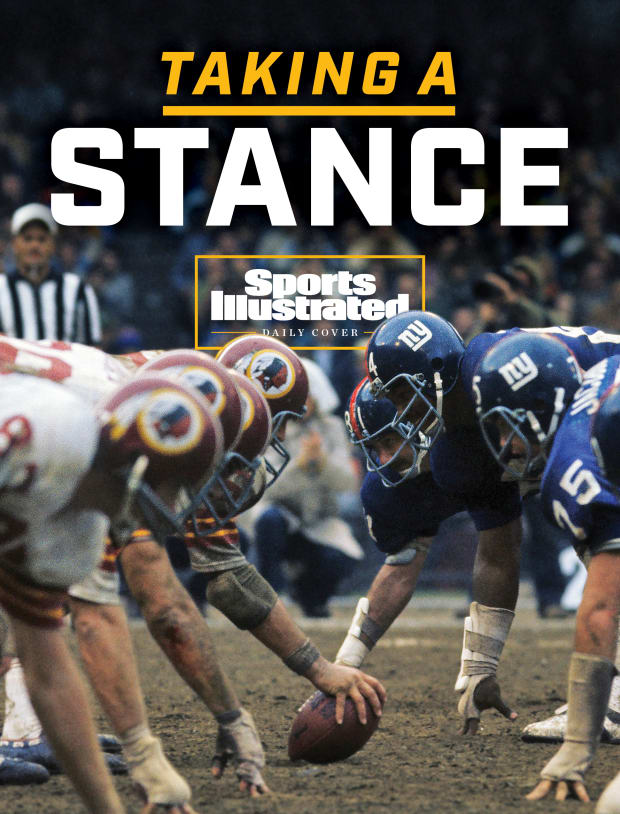
Neil Leifer/Sports Illustrated
If the game was unremarkable, this play was the opposite. Here, and on three other third-down Miami stops that afternoon, the Dolphins called for a novelty that may soon be the norm. Coach Brian Flores’s team countered L.A.’s sprawling shotgun formations with the so-called amoeba defense—a shape-shifting alignment that is difficult to decipher presnap and, notably, puts zero defenders in down stances. (Flores had previously used the amoeba in his years coaching the Patriots’ defense. Before that, it was employed by the versatile Ravens’ D in the early 2010s.)
Miami’s approach, while uncommon, was effective last season. The Dolphins tended to deploy the formation a handful of times each game, gaining an edge by obfuscating who might pass-rush, and they had the NFL’s top third-down defense. On a bigger level, the strategy also produced a crucial win for players, and for the game itself. Rather than dropping low for leverage, linemen engaged in foot races and shoving matches along a higher plane, and those plays were largely absent the clatter-crack of colliding helmets.
That percussion is so familiar, so essential to the sport, that it often blends into the background. But while rules have been implemented at every level of football over the past decade to prevent, detect, diagnose and treat concussions—specifically, concussions generated by thunderous open-field hits and most often suffered by star players—reams of research suggest that it is, in fact, these oft-overlooked men in the trenches, each of their 1,000-plus helmet-on-helmet thuds each season a discrete act of violence, who are in most dire need of protection. And mandating that they start each play standing up, like the scene in Miami last fall, appears to be one of the most potent means of protecting them.
Already a shift is afoot at the foundational levels. In 2017, USA Football, which provides coach-training programs and best practices for the youth game, introduced an alternate format that called for linemen to begin each snap in an upright stance. And in ’19, Pop Warner, with its 300,000 players, followed, banning both the three- and four-point stance among 5- to 10-year-olds. That policy will soon extend to older age groups each year, so that one can imagine linemen some time in the near future reaching high school, perhaps college, without ever being taught to place a hand in the dirt and thrust their helmet forward at the snap.

High-ranking medical officials from Pop Warner, the National Federation of State High School Associations (NFHS), the NCAA and the NFL all acknowledged to Sports Illustrated that they are aware of the risks posed by repetitive head impacts. Most have taken incremental steps to remedy the issue, mostly by reducing the volume of contact permitted in preseason practices. None, though, have ruled out the idea of prohibiting down stances in the future. Even commissioner Roger Goodell, when pressed on the subject at Super Bowl XLIV, in 2010, entertained a question about such a change. “Tonight you’ll see a lot of players that never get down in a three-point stance,” he said. “So, it’s possible [a shift] would happen.”
In other words: Reducing the volume of head impact is, at least, on everyone’s mind. But any meaningful adjustments to the game will require reforms both subtle and significant—in playing rules, culture, equipment, coaching techniques and practice cadence. They may even entail neutering something as instrumental to football as the power running game. But there are many who believe that it should start with mandating a style of play akin to those Dolphins-Chargers third downs—and that when that happens “this whole head trauma thing could go away,” says Eric Nauman, a Purdue professor of mechanical engineering whose team has studied head-impact exposure in football for more than a decade. “To the point where it isn’t that much more dangerous [to the brain] than playing softball.”
The damage that football inflicts on the brain was far more acute in the sport’s nascency than it is today. In 1905 alone, at least 18 players died, most from fractured skulls and mangled spines. The NCAA was formed the following year, adding the forward pass to spread out the field and reduce lethal scrums. Helmets were mandated in the ’40s; spearing was banned by the NCAA in ’76; the head slap was written out of the pro game a year later. Rules have been crafted to dissuade targeting defenseless players and leading with the helmet; return-to-play protocols have been honed; medical spotters were added. All in the name of preventing concussions. With each modification the game has gotten markedly safer—and, as a byproduct, tilted in the offense’s favor. Defenses can no longer rely on the specter of traumatic injury to stifle opponents.
Throughout all this legislating, however, line play has remained largely untouched. Meanwhile, study after study has demonstrated that linemen experience a disproportionately high number of blows to the head, particularly offensive linemen, who suffer well more than double that of most other positions. And data have piled up suggesting that volume of impacts, not simply the force of a given hit, most directly increases players’ vulnerability to both immediate and chronic cognitive changes and impairments. Even in the absence of diagnosed concussions, linemen are more likely than other players to report suffering headaches and dizziness and seeing stars. At season’s end, they are more prone than players at other positions to demonstrate deficits in memory and exhibit alterations to their white matter, the vital tissue that connects brain cells.
Joe Thomas grew accustomed to this sort of punishment at left tackle for the Browns, where for 11 seasons he added to the cacophony of helmets crashing along the line. Edge rushers like James Harrison and Melvin Ingram, he says, were trained to wield like a weapon the five pounds of polycarbonate wrapped around their heads. “They’d get their heads as low as they could—they were trying to headbutt you, shock you,” says Thomas, 36. “It was very effective.”
Another player well versed in those tactics: Corey Simon, who in the 2000s was judged by his ability to thrive with his head down and his hand in the dirt. The retired defensive tackle now oversees Pop Warner football in Tallahassee. And when the national outfit banned down stances for its youngest players, Simon didn’t think twice about lost traditions. Some coaches resisted, he says—at least at first. Others were confused. So Simon went to the film, showing clips of NFL teams in the amoeba D. On the other side of the ball, he reminded coaches: Many college and pro linemen already stand up on more than half of their snaps, as the shotgun and spread are becoming the norm.
“People often fight against the things they don’t understand,” says Simon, 44, “but the game hasn’t changed—it still looks and feels the same.” And the caliber of the product on the field, he reports, hasn’t worsened.
Though Simon takes pride in having played through pain himself, he applauds the effort to make football safer than it was when he played and knew little of the risks. He remembers the time he was knocked unconscious in practice, teammates dropping to their knees as he was hurried off in an ambulance . . . and he remembers how he was taught to get his helmet under a lineman’s chin on every play to gain leverage.
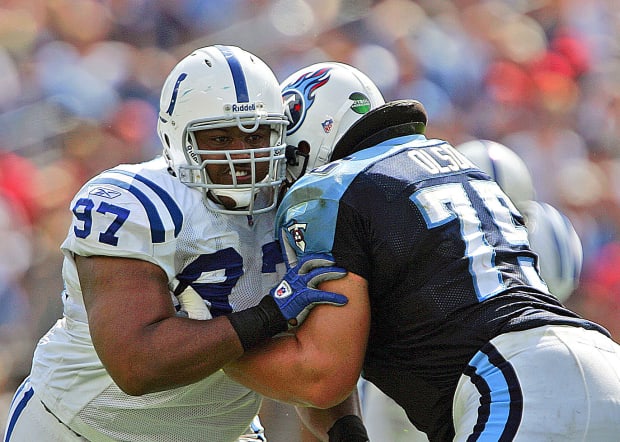
Doug Pensinger/Getty images
Stanford professor emeritus of emergency medicine Paul Auerbach (who died in June) was an early believer that eliminating those down stances would reduce head impacts, and his views on the subject drew the attention of Nauman’s team at Purdue, leading the two to collaborate in 2018 to test this thesis. The group found a live laboratory and willing partner in the Spring League, which had launched a year earlier to develop undrafted prospects. Researchers affixed sensors behind players’ ears to measure impact forces and—in a step unique from many other studies tracking football-related head impacts—compared the data with game footage to determine how technique and presnap stance influenced the volume of hits.
The group found that O-linemen starting in an upright stance experienced 40% fewer moderate head accelerations (20 g-forces or more) than when they began with a hand in the dirt. What’s more, the volume of those events was disproportionately higher on run plays than on passing plays (though starting upright helped nearly halve those incidents). O-linemen, cumulatively, experienced 98 moderate head accelerations in the game the researchers analyzed, nearly double that of D-linemen, and multiples more than other positions.
Those results were released in 2020, and the Spring League subsequently banned down stances for O-linemen. The reaction, predictably, was not one of universal enthusiasm. One assistant, recalls Spring League CEO Brian Woods, was incensed that the craft he’d built his life around had been upended in an instant. “That’s the struggle with innovation,” says Woods. “There’s a lot of that old-guard mentality.”
If down-stance prohibitions stirred up mild controversy in Pop Warner and in the Spring League, what might happen if the change works its way up to football’s highest levels? While much of the conversation has pertained to offensive linemen, Rams tackle Andrew Whitworth, for one, believes that any such requirement must be matched by a comparable one for defensive counterparts—not just for safety but for fairness. In many situations, says the 39-year-old veteran of 15 NFL seasons, D-linemen could easily gain leverage if they were allowed to start down against an upright guard or tackle on most run plays. Whitworth worries, too, that short-yardage situations—particularly on third and fourth down, and along the goal line—could be rendered formalities. If both sides were forced to start up, he says, the offense, almost always larger by default, could easily overpower the defense on short runs, robbing the sport of its most suspenseful moments. “Short yardage,” Whitworth says, “is such a massive, cool part of the game. But it would basically be gone if [we all] stood up.”
Thomas, the retired tackle, estimates that by his final season, in 2017, he was starting upright on about 60% of snaps. In other words: A change wouldn’t be that big. If the rules were to shift, though—if all linemen were required to start up—he thinks head contact would initially diminish . . . but D-linemen would eventually adapt and find new ways to gain leverage. Inevitably they would use their helmets again, and “the low man would still win,” Thomas says. “Coaches and techniques would adjust, and you’d end up back at square one.”
Rather than mandating a specific stance change, Thomas thinks the league might be better served by outlawing certain types of blocking schemes. He points to how outside-zone running plays, popularized in today’s game by the likes of 49ers coach Kyle Shanahan (page 42), require linemen to use speed and technique to angle defenders into certain positions, rather than taking on opponents squarely, often helmet-first, like in traditional power-running schemes.
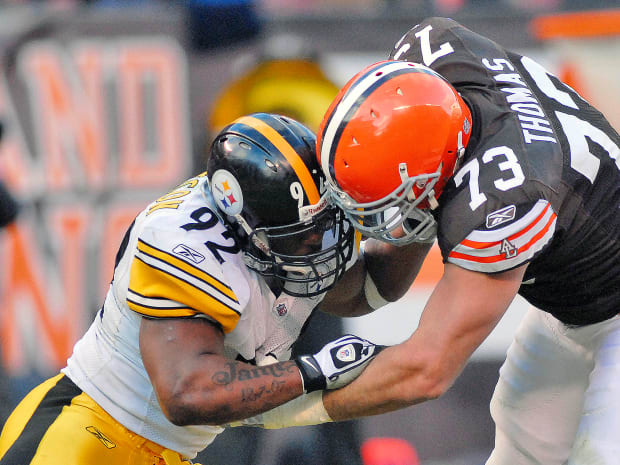
David Dermer/Diamond Images/Getty Images
Any change, though, will require more than just convincing players. The barriers to football reform are real. At the NFHS, for instance, a proposed change can be brought forward by any state high school association, but it must earn two-thirds of a vote from across 52 members. (An NFHS ban has been discussed, but no formal proposal has yet been put forward.) “We’re trying to limit repetitive head trauma as best as we can,” says Michael Koester, the group’s outgoing sports medicine committee chair, “without going overboard.”
One level up, NCAA chief medical officer Brian Hainline says mandating that linemen stand up has already been the subject of discussions, but he warns against hastily reshaping the game before the data are clear. He notes that what works for players in developmental stages may not be appropriate for higher-skilled athletes.
And at the very top? NFL execs say they’re waiting on more robust data from cutting-edge mouthguard impact sensors (currently in use throughout the league), married with video analysis, before identifying what future rule changes might be warranted, but none offered a timeline. Eventually, though, that data will speak. And when it does, “we’ll go where the data leads us,” says the league’s chief medical officer, Allen Sills. “Changing the future means reducing head impacts overall. Period.”
Troubled by early reports of CTE among football players, Dartmouth coach Buddy Teevens announced in 2010 he was outlawing tackling in his practices. His assistants sat waiting for the punch line, and they were aghast when it never came. Friends in the coaching community told Teevens his approach “wasn’t football.” The rebuttal, though, was in the results. Before the change, the Big Green had won only two of their 20 previous games. Since tossing tackling aside, Teevens’s teams have won 70% of the time. They’ve captured a pair of conference championships. And, most importantly, injury rates have plummeted.
Teevens’s next big move at Dartmouth: limiting contact along the line. He’s introduced zone-blocking techniques to his offense, similar to those Thomas speaks of admirably. In drills he usually restricts linemen to working against pads. If there has to be man-on-man contact, he begins with players already engaged, forcing them to work on technique instead of just surging into one another from a down position. He’s not thrilled about the prospect of banning down stances and reshaping how the sport is played along the line, but he thinks coaches could drastically limit head impacts among linemen by making similar modifications to practices and drills.
Teevens has been happy to see other teams and conferences follow his lead on tackling—the Ivy League, for instance, banned it in practice in 2016—but he says longstanding cultural and structural barriers have stifled progress. “Everything in our game right now is Win or be gone,” he says. “Are you going to say, ‘I think this really is the best thing for my players, so—screw it—we’re not going to tackle anybody’? Then you go 0-fer and you’re unemployed.”
Hainline was hired to build bridges across those cultural fault lines, and it has helped his cause that the conversation has changed since he was hired in 2013 to be the first chief medical officer of the NCAA. (Editor’s note: The author was previously employed by the NCAA as a writer and editor.) Back then, the notion of head-impact exposure alone being detrimental was still a “concept,” he says; research and policy were largely geared toward studying, preventing and diagnosing concussions. Eight years later, the scientific community understands that exposure alone to low-level head impacts can change the brain.
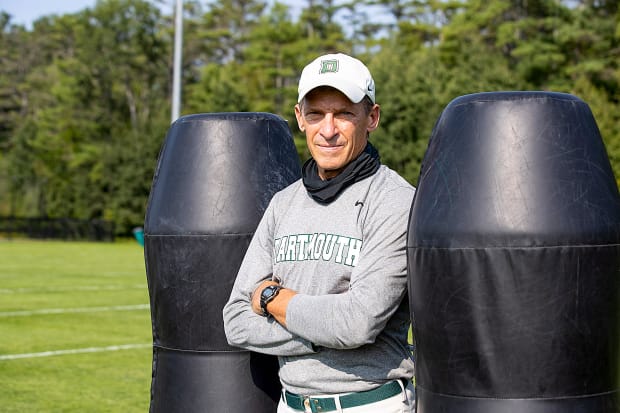
Damian Strohmeyer/Sports Illustrated
As the science is sorted out, the NCAA has taken incremental steps to mitigate exposure. Weighing data from several studies, including one at LSU that indicated players—particularly linemen—absorbed as many impacts in two-a-day practices as they did in games, the NCAA scuttled the longtime two-a-day rite of passage in 2017. Here, however, college football culture and the best intentions of the medical community didn’t mesh. A follow-up study to the two-a-day ban, conducted at the Medical College of Wisconsin, discovered that in the subsequent preseason head-impact exposures actually ticked up 26% because coaches, likely fearing they wouldn’t be able to adequately prepare their teams, turned up the intensity at one-off practices. The latter findings led the NCAA one year later to cut the number of permissible contact-practice days in the preseason. And on it goes: action, reaction . . .
This year brought a slew of new rules designed to mitigate impact exposure and concussion risk in the college preseason. Contact practices were reduced further, from 21 to 18; and drills that inherently trigger helmet-to-helmet contact, like bull in the ring or the Oklahoma Drill, were finally banned. But for coaches, says American Football Coaches Association executive director Todd Berry, “There was some frustration.” Navy’s Ken Niumatalolo said a lack of contact in practices last preseason made his team the “softest” he’d had. Coastal Carolina’s Jamey Chadwell worried that diminished contact in drills would hinder his young players’ development. Further hurting science’s cause in convincing these coaches: A recent study by the NCAA- and Department of Defense-funded CARE Consortium acknowledged that amendments to college football’s preseason schedule over the past five years have had “a limited effect in reducing preseason concussion incidence and head-impact exposure.”
What’s clear is that some degree of coaching buy-in will be necessary to effect actual change—especially when you weigh data from the CARE Consortium that show the player-by-player volume of exposure to head hits can vary wildly within the same team, even within the same position group, suggesting that technique might play a vital role in protecting individuals. It would seem crucial then that researchers in the sprawling CARE study better understand what techniques and drills generate head impacts, much as the Purdue team did when it had access to Spring League video. But Brian Stemper, a Medical College of Wisconsin professor of neurosurgery who has done extensive work with CARE’s impact data, says that he—and many fellow researchers—haven’t had access to the NCAA practice film that would enable them to make those sorts of comparisons.
Why not? Why are coaches so “possessive” of that film, as Stemper says? Berry, speaking for college coaches, admits to a sense of paranoia—a fear that our Nick Sabans and Dabo Swinneys would face competitive disadvantage if that video somehow fell into an opponent’s hands.
And without film, Stemper says that “identifying individual playing styles will be hard for us.” Which represents a bit of an impasse. Convincing college coaches to willingly hand over practice tape, or to tamp down on contact within the confines of practice restrictions, may be the ultimate impediment to progress.
“Trust,” Hainline says, “has been the biggest challenge.”
At the NFL level, at least, things have changed enough already that one lineman says he feels safer today than when he started. When Andrew Whitworth was drafted, in 2006, helmet-to-helmet contact among linemen wasn’t just common. It was mandatory. “You were taught that if you ever tried to pull your head out of a block, or tried to not use your head,” he says, “you were a wuss or a punk.”
Fast-forward 15 years, through sweeping league-wide shifts in playing style and coaching philosophy, and Whitworth believes he absorbs far fewer blows to the helmet. (His gauge: diminished postgame neck soreness.) In today’s game, teams use shotgun formations, in which linemen typically start standing up, on roughly 60% of plays—more than triple the rate of his rookie year. Beyond schematic overhauls, Whitworth says the Rams’ recently departed line coach, Aaron Kromer, insisted that players use their hands and shoulders to steer blocks rather than instigate contact with their heads, the opposite of what Whitworth and legions of linemen had been taught for decades.
Part of that is driven simply by adherence to new rules and guidelines. In 2018, NFL referees started penalizing players—mostly tacklers and ballcarriers—who lowered their heads to initiate contact. Last season the league emphasized that those penalties be called along the line, too, policing the sort of helmet-first bull rushes that Whitworth and Thomas dealt with through much of their careers. (Thomas, watching from home, observed that this new enforcement “didn’t change anything—because that’s what blocking is: hitting helmets.”) While league execs say the impact data aren’t yet robust enough to measure whether last year’s monitoring of line play had a demonstrable effect, they acknowledge that answering those questions is essential.
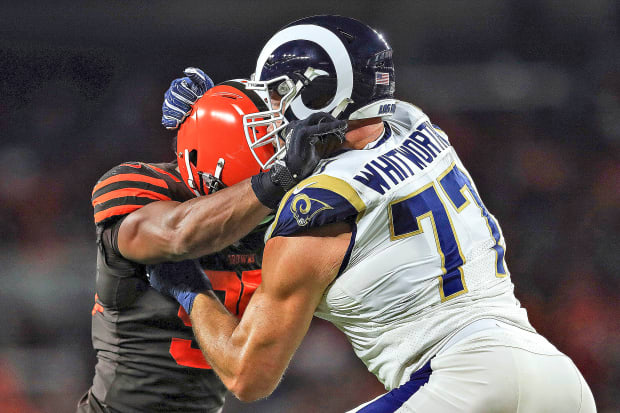
Aaron Doster/AP
“Players along the line are more likely than somebody in space to have head impacts during the course of the game—full stop,” says Jeff Miller, the NFL’s EVP for health and safety initiatives. “I think we’re going to learn more and more . . . and hopefully continue to evolve our rules and practice types to avoid some of those [hits].”
The notion that linemen are particularly vulnerable isn’t new. In a 2013 paper, neurosurgeon Julian Bailes first posited that repetitive head impacts—what he termed at the time as “subconcussive” hits—appeared to be a key contributor in long-term cognitive problems, and that they were disproportionately suffered by linemen. He even suggested a three-point stance ban.
Thom Mayer, the NFLPA’s medical director, remembers being in the room when Bailes addressed the league’s mild traumatic brain injury committee after that paper’s publication. And he remembers watching eyes roll. “He was treated like a pariah,” says Mayer. But a half decade later, Bailes sits on the NFL’s Head, Neck and Spine Committee, and serves on a comparable NFLPA body, suggesting that his old ideas are at least being entertained at the highest levels. Sills, the league’s chief medical officer, points out, too, that a significant portion of the NFL’s $100 million (and counting) investment in health and safety initiatives is focused on this issue. The new CBA, signed one year ago, targeted impact exposure directly, cutting padded practices in training camp from 28 to 16—that after the league eliminated full-contact two-a-days in 2011.
And yet the crashing continues, as equipment manufacturers can attest. The helmet manufacturer Vicis has a policy of refurbishing the lids it provides to teams every two years, and as the helmets arrive back at the company’s headquarters in Seattle, VP of product development Jason Neubauer says that, without fail, he can differentiate a lineman’s helmet from the rest. Beyond the chipped paint on the face mask, the crown of a lineman’s helmet is typically checkered with gouges and scratches, far more than those worn by skill-position players or even linebackers.
Helmets are designed to prevent skull fractures. They’ve done that job with aplomb for nearly a century. But the hard shells necessary in preventing cracked craniums do a poor job of protecting the brain, and they do little to shield linemen from a litany of lower-level impacts. There, too, science is lighting the way. Based on research that demonstrated where and how hard linemen tend to get hit—mostly along the forehead, mirroring the usual pattern of scuffs on those returned helmets—Vicis last year introduced the Zero2 Trench, the first helmet designed specifically for the position. Really, the helmet is a tricked-out version of Vicis’s standard model, with an attachable, more-pliable crown—designed specifically to absorb and disperse softer impacts—affixed to the outside of the hard shell.
The new Vicis model won’t be a silver bullet, but it—and future position-specific equipment evolutions like it—can be tools in solving the impact-exposure conundrum. Still: “Are we sure those helmets will work?” Mayer asks, rhetorically.
“I’m not sure of anything.”
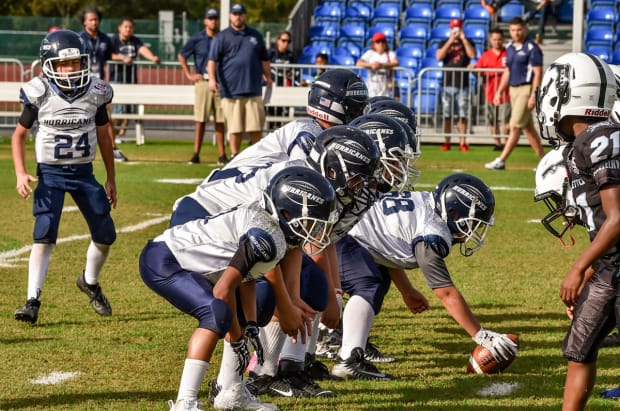
Courtesy of Pop Warner
In 2010, when the Purdue team first realized that players’ brains were changing simply from playing the sport, not merely from sustaining concussions—a breakthrough concept at the time—a story about its initial findings ran in these pages. In the years since (in part spurred by litigation), the NFL and NCAA have spent millions funding research designed to better define, prevent and diagnose concussions. That work has spurred cultural change: Crowds now groan instead of cheer after vicious hits, players are more apt to report concussion symptoms and concussed athletes sit out far longer than they did a decade ago. But impact exposure has remained an ancillary concern. “Personally,” Nauman says with a sigh, “I’ve kind of given up on really being able to have a big impact.”
Still, in seeking the sort of evidence that can’t be ignored, the Purdue team today eyes the results from its initial Spring League research, which proved so promising that a larger follow-up study was conducted in 2019. While the results of that follow-up remain in peer review, the researchers say the findings echo the initial study: Linemen suffered fewer head impacts when starting up and on pass plays. Beyond that, the new study also found that when starting in two-point stances, more-talented players proved better at avoiding contact than their less-skilled peers, reinforcing the idea that coaching will be just as important as any future rule changes.
Perhaps soon that sort of evidence will be incontrovertible, and football will again be reshaped to protect its players; perhaps linemen will be required to stand, leading the on-field product to further favor speed and skill over brutality.
In the meantime, strategic changes—toward shotgun and zone-running schemes, and toward defenses built for dexterity and deception—have coaches evolving in ways that, coincidentally, for now, ask linemen to stand more and to use their heads less. In lieu of some drastic rule change, the impact of these shifts on linemen’s health will continue to be incremental, their underlying effects rendered over time. Just like the hits themselves.
• The 9/11 Story That Inspired Tom Brady
• Colin Kaepernick Went First. They Were Second
• Dak Prescott’s Heal Turn

0 Comments